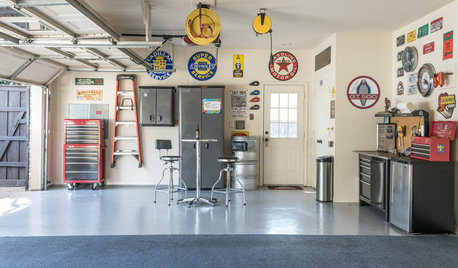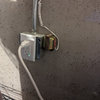How should a 2-prong outlet be grounded?
We recently purchased a house built in 1960. During our inspection, we found out that many of the outlets in the house are not grounded. A few of the outlets were grounded at some point, but the prior owner put 3-prong plugs/covers on all the outlets. The prior owners refused to have all the outlets grounded, claiming it would make a mess of the walls, but they put 2-prong outlets back on the ungrounded outlets so we could tell which are safe to use.
We are hiring an electrician to ground the outlets in the room that will house our office and exercise equipment. We will be plugging in computer equipment, an elliptical machine, TV, etc., so we want to make sure the work is done right for safety and so our equipment does not get fried. A GC we know said his electrician can ground the outlets for $33 per outlet. He said it is something that is done at the outlet itself, they do not have to run anything to the main panel. The electrician is coming over tomorrow, so we will ask him exactly what he plans to do, but before we talk with him, I want to know the proper way to ground an outlet so I know if what he is proposing as a solution is proper.
So, how should an outlet be grounded? How much wall damage should we expect? TIA!
Comments (31)
azlighting
13 years agoI would only accept new 3-wire conductor wires ran. Anything less would not be properly grounding the receptacle in my book.
Related Professionals
Belleville General Contractors · Henderson General Contractors · Mount Vernon General Contractors · Rossmoor General Contractors · Lynwood Solar Energy Systems · Mokena Solar Energy Systems · New Canaan Solar Energy Systems · Danville Home Automation & Home Media · Englewood Home Automation & Home Media · Lehi Home Automation & Home Media · Medford Home Automation & Home Media · Oak Hill Home Automation & Home Media · Oceanside Home Automation & Home Media · Scottsdale Home Automation & Home Media · Sun Lakes Home Automation & Home Mediatexasredhead
13 years agoFor decades, electrical systems were not grounded and probably many still are not. Short of rewiring the home, one method is to find a receptacle closest to the panel on the circuit you want grounded and install a GFCI in that receptacle. Basically, if a ground fault occurs from a defective piece of equipment or appliance, it will trip the GFCI.
Whether a circuit is grounded or not, computers are typically protected by surge protecters. A grounded outlet will not protect computer equipment by itself.
IMO, It would appear that the grounded circuits were added at a later date to the original ungrounded wiring of the home. A way to tell for sure is to remove a "grounded" reeptacle plate to see if the receptacle is actually grounded.
brickeyee
13 years ago"using the metal sheath of type AC cable (often referred to as BX) as the ground conductor - not reliable "
Perfectly acceptable and reliable.
AC cable has a bonding strip , unlike the much old actual BX cable.
Anything with a 2-prong plug does not have a ground connection anyway.
How many 3-prong devices do you have in the rooms?
Very few lamps have more than a 2-prong polarized plug so a ground has no benefit.
E;ectronis and computers often DO need a 3-prong plug.
You can upgrade the existing 2-prong receptacles with GFCI receptacles. GFCIs do not require a ground to operate, and using them to replace 2-prong receptacles is a code compliant change. Be sure to put the stickers in the GFCI box onto the receptacles.
The GFCI itself gets the 'no equipment ground' sticker, and any other receptacles downstream from the GFCI that are hooked to its load terminals get the 'no equipment ground' (if 3-prong)' & 'GFCI protected' stickers for all.
The lack of a ground is not a significant hazard for general lighting circuits.
abbey_cny
13 years agoI was in a similar situation when I bought my house built in 1950. I had the electrician ground the outlet in the room where I had my computer. This room was at the opposite end of the house from the breaker box. He did a great job and I had no wall damage. Good luck wtih your electrician
spencer_electrician
13 years agoIf the electrician is like half the bozo electricians here in kansas city, he probably plans to bootleg the ground to the white (neutral) wire. I am constantly removing receptacles in houses that have a jumper from neutral to ground. Real estate agent related work at time of sale on houses with 2 prong receptacles often involves them finding a cheap enough electrician that is willing to unsafely do the bootleg method. All they care is that it lights up the inspector's plug tester to shut him up and get the house sold.
There is a chance that they plan to retrofit GFCI outlets for $33 a piece. Keep in mind they will have the safety but will not actually be grounded (not good for electronics, surge protectors, etc)
brickeyee
13 years ago"...retrofit GFCI outlets for $33 a piece."
$33 each is off the chart.
They run about $12 or a little more.
hrajotte
13 years agoIt is possible your house wiring DOES have a grounding conductor. I have a 1951 house that does. They still installed 2-slot receptacles and simply attached the grounding wire to a screw on the internal cable clamp.
So, we did a little pigtailing, installed 3-slot receptacles and that was that. The only challenge was finding a proper grounding screw to go into a hole in the box. I believe it was an oddball hole or thread size. We assumed that connecting the box grounding wire to the cable clamp was not acceptable, even if it's better than nothing. If I remember right, my dad got some screws from an electrical supplier. And we made sure the grounding wire was hooked up at the panel. Some electrician in 1951 had brilliant foresight and saved us a ton of work in 1982!
It's good that you're getting information ahead of time. As someone said, make sure they don't do an illegal, unsafe butcher job by hooking up a bootleg ground. Using GFI receptacles is acceptable and legal, but might cause problems with some computer exuipment and your exercise machines might cause false tripping.hexus
13 years agowhy and where are you guys buying GFCI's for $33 a piece?
I have a bridge to sell you too....
ontariojer
13 years agoUmmm, IF that is what they are going to do, I think the $33 includes labor, not just the GFI rec. So relax about the "you are being screwed on the price of GFIs" bit.
brickeyee
13 years ago"The only challenge was finding a proper grounding screw to go into a hole in the box. I believe it was an oddball hole or thread size."
Older metal boxes may not have a tapped hole for a ground connection, but the regular size is 10-32.
The hole may be present but untapped.
If there is no hole at all you can always drill one, then tap it.
Self tapping screws are NOT allowed for grounding connections.
They fail to pull up tight enough to make a gas tight seal between the metal of the box and screw threads.
Gas tightness is required for a long term reliable connection.DavidR
13 years agoIf the box has no tapped hole, you can use a grounding clip. Personally, though, I think drilling and tapping a proper hole isn't much more work.
Here is a link that might be useful: Grounding Clip
brickeyee
13 years agoWhile the grounding clips are allowed, I still do not like the reliability of a connection that is using a spring to ensure contact.
ionized_gw
13 years agoMy parents' house, built in 1959, had grounded boxes with two-conductor receptacles too. At some point, all were changed to 3-conductor as they wore out or became a pain. It screwed me up. When I was a young man and walked into a situation with two-prong receptacles, I assumed grounding was readily available at the box. What a rude awaking when I found that usually it was not ;-(
powerleg5
13 years agoI am sure that the $33 price includes labor costs to install the GFI receptacle, if indeed that is the route they are proposing.
Personally, if electronic equipment is going to be used here I would accept nothing short of a new circuit (or two) being ran back to the panel with a regular grounded receptacle installed in the room.
This can be done with no wall damage being done especially if this is installed on an inside wall. Getting the new
wire(s) into the electrical panel could be a different story but still possible without wall damage being done. This of course will cost more and will depend on the ability or desire of the electrician doing the work.This will be the only true proper way to handle this situation with electronic equipment being involved.
Do not accept the jumper wire method of bonding the neutral and ground lugs together as a quick and easy fix because it is quick and it is easy but it is not a fix nor a solution to the problem.
An installed GFCI receptacle might be code acceptable but it will not leave your electronic equipment grounded and could very well cause the GFCI to trip out and lose power when you least needed this to happen with your computer and whatever you may have been working on at the time.
Here is a link that might be useful: Your How To Partner.com
DavidR
13 years agoAn installed GFCI receptacle might be code acceptable but it will not leave your electronic equipment grounded and could very well cause the GFCI to trip out and lose power when you least needed this to happen with your computer and whatever you may have been working on at the time.
Not sure why you are posting this in a month+ old thread. The OP is most likely long gone, having already gotten his or her answer.
But to follow up on your comments - as I see it, your scenario of a GFI tripping and causing a computer to lose power is a little far-fetched.
- Nuisance tripping isn't that common with GFIs
- The additional safety to people is worth the small risk of data loss
- That issue is easily addressed by using a UPS
- Most people will want a properly grounded receptacle for a computer anyway.
All this is academic though, as it appears your main reason for posting in this old thread was to promote your website.
BTW, your website's name as typed here is confusing. You need a hyphen between how and to ("Your How-To Partner") for it to mean what you intend. As written it could easily mean "How to partner," that is, how to develop partnerships.
hexus
13 years ago"This can be done with no wall damage being done especially if this is installed on an inside wall. "
extremely bold statement to make. You have no idea at all if it can be done without wall damage. What if there's blocking in the wall? What if the area can not be reached from the attic, or from below? There are numerous things that could cause problems.
You making that statement (and others in your post... "This will be the only true proper way to handle this situation with electronic equipment being involved. " wtf!?) tells me you do not have proper experience or knowledgeTim
13 years agoHexus,
I have been in the electrical trade for nearly 30 years and I have been an Electrical Contractor for the last 18 of those 30 years. I have seen just about every situation that there is to see concerning these types of problems and solutions.I made that statement because there are ways to do this without wall damage, if you know what you are doing and I do because I have done it so many times.
I am not going to explain to you how to do it but if I were at the residence in question here I would show you how to do this without wall damage.
I am not sure what you meant with your comment about the electronic equipment but I would love to hear your explanation on it.
brickeyee
13 years ago"What if there's blocking in the wall? What if the area can not be reached from the attic, or from below? There are numerous things that could cause problems."
I have never se4en an inside wall that could notbe wired without cuting up the wall if it is under an attic or above a basement.
Fire blocking is easily drilled through with long drill bits.
I routinely use 1 inch on top/bottomn plates form the attic/basement then look around/measure to see how far till the first blockage.
You can then go through th e1 inch hole wwith either a long flex bit or ships auger (I have one 60 inches long x 5/8 inch).
With a one inch holke you can even use 1/2 inch extension shaft sections.It just takes more time to get access wihtout dmaging walls.
You can even bore across the wall fromthe box with a flex bit, or from a door jamb with a simple repair to a painted jamb.
hexus
13 years ago"What if the area can not be reached from the attic, or from below?"
guess you missed that part eh "brickeyee". Saying it, and actually doing it or two completely different things.
I'm done, your arrogance lately in every post you make is too much even for me, it's not just this either. Every thread you post in you're pretty much just an ass.
brickeyee
13 years ago"guess you missed that part eh "brickeyee". Saying it, and actually doing it or two completely different things. "
"You can even bore across the wall fromthe box with a flex bit, or from a door jamb with a simple repair to a painted jamb. "
Guess yo missed that.
Reading must be very hard for you.
Sideways works just fine, it just takes more time and care.
And patching walls is normally very easy (the only thing that can make it hard is heavy texturing).
Guess you never though of that.
Try growing up.
btharmy
13 years agoWow guys, grow up. There ARE locations not accessable without damaging the wall. It's just a fact. Anyone who says they can get to ANY location in a house without cutting a wall or ceiling now and again is lying. Lots of houses have slabs and 2nd floor rooms = no access from above or below on interior walls. Not sure why anyone would argue one way or another. It is always a case by case basis. There are no guarantees in our line of work. There are always challenges. Thats why it is a "skilled trade". Granted, some are more lazy than others and won't go the extra mile to save the homeowner the cost of patch and paint.
brickeyee
13 years ago"There ARE locations not accessable without damaging the wall."
You need more tricks then.
One of my favorites is drilling horizontally across the wall.
I even have a 'drill frame' built that operates using sections of pipe with inside threaded couplings to keep the outside a uniform diameter.
It turns about 20 RPM.
The furthest I have gone with it is about 20 feet across a heavily textured plaster on wood lath wall.
Using the hole for a new box to access stud cavities and then orking horizontally from box hole to box hole with flex bits is another trick. Installing an old work box also allows you to make holes in walls and not have to repair them.
For larger holes in framing hole saws using square drive extensions at low RPM allow you to reach and then see through the larger holes.
I even use rigid and flexible bore scopes to peek inside walls to avoid hitting existing wiring and plumbing.
You need to carefully wight the labor hours to minimize wall damage against the cost of repairing the wall.
Some customers are willing to pay the higher electrical labor charges to avoid wall damage, while others are not bothered by the need to paint patches.
Instead of just a few hours to add an outlet it can take an entire day.
Even patching can be accomplished quickly if you use EasySand20 setting compound (though it still needs to dry about 24 hours before paint is applied).
I have only met a few electricians who seem to know hot to patch walls.
Most leave it to a drywall guy, prolonging the job for the customer.scottys
13 years agoMy house circa 1953 has all 2 slot outlets except in the kitchen, laundry and garage. I think most people freak when they hear it "is not grounded" because they think it's unsafe or they will get a shock. As someone mentioned above, most all things we have in our homes only have 2 prong plugs on them and the 3rd ground slot is not even used....so leave your 2 slot outlets alone in bedrooms, dining rooms etc. Sometimes, older wiring is best left undisturbed anyway.
fixizin
13 years agoYou need more tricks then.
One of my favorites is drilling horizontally across the wall.
I even have a 'drill frame' built that operates using sections of pipe with inside threaded couplings to keep the outside a uniform diameter.
It turns about 20 RPM.
TOOL-time! Awesome! URR, Urr, urr!... PICTURES!
The "Brick" sets out to CONQUER the problem, not just solve it!
I have only met a few electricians who seem to know hot to patch walls.
That many? There may be ZERO in So-Fla... home of... The Slacker Factor. :(
brickeyee
13 years ago"The "Brick" sets out to CONQUER the problem, not just solve it! "
After 30+ years of renovating houses (some dating to the 1780s) and trying to in most cases avoid any more damage than required to upgrade them so they remain usable structures, there are a lot of tricks that are often not readily apparent.
Long before long flex bits become a commercial item we made them by welding a length of auger bit onto a 1/4 inch (sometimes 3/16 inch) section of drill rod.
If you needed even more reach you could weld a section of larger drill rod to a smaller one and create a 'socket' that used a couple of set screws to hold the sections together.
For simple straight holes either 'ship auger bits' (I have one over 60 inches long) or a shorter bit with extension sections did the job.
It is a very different world than commercial work or new work, especially on old and/or historic structures.
In many cases receptacles could be placed horizontally in baseboards, but it was often still a chore to get the branch circuit conductors to them.
Drilling horizontally from a door jamb created an easily repaired hole in the jamb (often made with a hole saw so a plug could be used in the repair) while allowing receptacles to be placed within in the stud cavities or on the baseboards with no access above or below.
Even hole saw extensions were being made before they hit the commercial market.
I have ones that use 1/2 inch or 3/8 inch square drive socket extension rods.
How far away do you need that hole from an access point?
When you cannot purchase a needed tool you just make it.
Matt
12 years agoBrickeyee. You are just stupid or very very lucky. Drilling blind horizontal through walls are asking for trouble. I hope your lame as hits a water line, better yet a gas line. Your luck will run out and hope your insurance drops you stupid lame ass. You probably don't have any.
brickeyee
12 years agomatfos,
Maybe you should learn how to do the job better.Before drilling horizontally you survey the wall, even going so far as to use metal detectors and bore-scopes in tiny (1/4 inch) hols to look around and see what might be in the way (you have heard of these tools, right?).
Steel pipe is not much of an issue it it is hit.
An augur type drill bit will not penetrate, but will be deflected to the side (if not stopped) and can deflect and no longer follow a straight path (especially on a flex bit).In one historic house we went so far as to x-ray the walls since it was not apparent how they had been finished inside the post and beam construction. It was a huge job moving the lead around to block the x-rays from continuing past the film plates.
Smooth walls remain pretty easy to repair, with textured or decorated plaster abut as hard as it gets.
Sometimes the shortest path is NOT the way to go.
Instead of massive ceiling repairs to go across joists you can go horizontally until you can run parallel to the joists.None of it is inexpensive, but when you roll in all the costs for repairing things (especially in historic properties) it often ends up lowering the total bill.
I can send a crew to bore holes, and then an electrical crew to pull the wiring.
I do have one electrician who is pretty good at fishing cables, but most of the younger crowd seems to want to get in and out as fast as they can with no consideration to minimizing wall damage since 'that is someone else's problem'.
I use them for new commercial work, when it is available.Even how you cut into walls can drive the costs of repair.
In 2 coat plaster wall (gypsum backer board) or drywall, careful cutting with a Rotozip allows the removed section to be the patch, saving a lot of time in any repair required. Hole saw holes work almost as well (save the core).Even keyhole hand saws and Sawzalls are the last resort.
And if I ever see a hammer bashed hole someone is simply removed from the job site (and any further employment).
Futbol9
9 years agoHello everyone. Have a question? Bought a freezer that Needs to be plug in in a grounded outlet. The problem is that where i want to plug in the freezer is a two prong ungrounded outlet. Dont want to run wires to main breaker box to grounded it. I was told i could run the ground cabble From a grounded outlet to ground My ungrounded outlet or also just to replace it with a GFCI receptacle? Just Wanna start using My freezer already:(. Thank u Guys for ur help.
Futbol9
9 years agoCan i ground a two prong outlet by just pulling grounded cable From A grounded outlet? Or should just replace it with GFCI receptacle? The outlet i Wanna ground Has two black and two white cables coming out From wall. Bought a freezer and need a grounded outlet to plug it in:(. Thank you very much.





















randy427